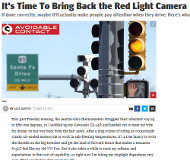3/31/2017
OPINION: Road And Track Is Wrong About Red Light CamerasA commentary explaining how the Avoidable Contact column in Road and Track makes a fundamental mistake about red light camera effectiveness.

A Road and Track column published last week mused about the potential of using automated enforcement in a positive manner (view original column). Its author, Jack Baruth, is full of wishful thinking in his call for the return of red light cameras. The same wide-eyed, gullible types who think the mere act of painting a number on a sign suddenly makes the public adhere to a speed limit's arbitrary value tend to also believe the presence of red light cameras magically reduces red light running.
Experience proves this is not the case.
The most reliable figures come from the Virginia Department of Transportation's 2007 comprehensive study of camera programs that showed a 29 percent increase in accidents where cameras were installed throughout the state (view study). The biggest jump came from rear-enders of the sort that happen when a Prius driver terrified of getting a ticket slams on the brakes at the first hint of yellow light, surprising the guy behind who is not nearly as quick to stab his own brakes. As any motorcyclist knows, rear-end accidents can be even more dangerous than the T-bone scenario, because once you are no longer moving, nothing can be done to avoid a collision.
Of course, as Baruth noted, there is a red-light-industrial-complex, and it has created reams of "studies" claiming that camera enforcement works. Nearly all of the early studies of this type were conducted by the same guy, Richard Retting, who has since left the Insurance Institute for Highway Safety to work straight up as a contractor for a red light camera company in Maryland. Follow the money, and the junk science reveals itself for what it is.
The idea that accidents would be go down if the camera programs were "done right" is naive. First of all, license points are already deducted for photo violations in Arizona and California. Incidentally, that is precisely why the insurance industry loves cameras -- the increased insurance premiums represent pure profit for the industry. But the prospect of points has not stopped red light running in California.
We also know that no city in the United States will run a red light camera program that makes no money. The people of North Carolina adopted a constitutional amendment requiring all fines be sent to schools. The courts eventually ruled that this provision meant cities could not use fine money to pay private red light camera contractors. Instead, towns would have to dig deep into their own pockets to continue ticketing programs. None took them up on that offer, and the cameras went silent.
Tar Hel State lawmakers recently adopted legislation (of dubious constitutionality) to skirt this issue, and the cameras have been making a comeback -- which is why it is rather silly to assert that the era of automatically milking motorists is over. Sure, the CEO of one camera company got caught bribing state officials and is serving time for her crimes, but there are half a dozen other unindicted companies willing to pick up the slack.
Cameras are hardly the only means of restoring respect for red lights. We got along just fine as a nation for almost a century without them. Actual studies, rather than random musings made while waiting at a stoplight, suggest that the single biggest factor in red light running is the length of the yellow warning light at an intersection. This is also confirmed by confidential camera industry documents that show cameras are only to be installed at intersections with high traffic volumes and short yellows.
We got those short yellows because the engineering community decided some twenty years ago to systematically cut the amber period by about a third. Whether the motivation was increasing intersection throughput or enabling the red-light-industrial-complex is beside the point. We are being shortchanged by a flawed formula.
Both Ohio and Georgia recognized this and instituted state laws requiring a blanket increase in yellow time of 1 second. After the change, red light running decreased 70 to 80 percent overnight. Georgia's number-one camera vendor at the time, Lasercraft, went bankrupt.
That did not kill the industry in Ohio, which quickly adapted by introducing speed cameras and focusing on rolling right turn violations, which are not dangerous but can account for up to 90 percent of an intersection's citations. These sorts of thing are inevitable when dollar figures are assigned to violations. Enforcement becomes a money-making operation that goes after the softest targets -- technical "gotcha" infractions that happen in large numbers but have no safety relevance.
The world in which we have cities that do not care about the money, endorse longer yellow times, and embrace the common good of humanity is the same one where there is already world peace, a flying car in every driveway, and we all sing Kumbaya in perfect harmony. If Jack Baruth thinks either world is a realistic possibility, he is nothing but a dreamer.


